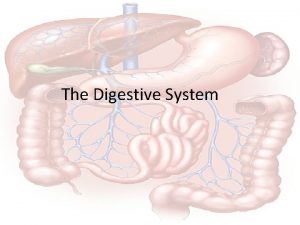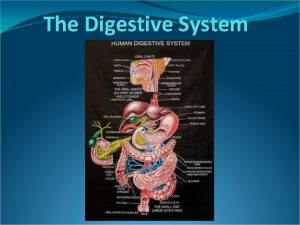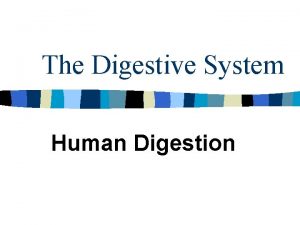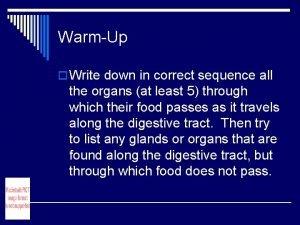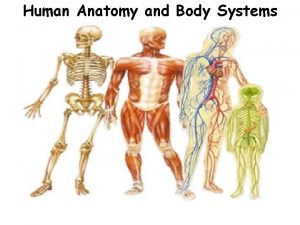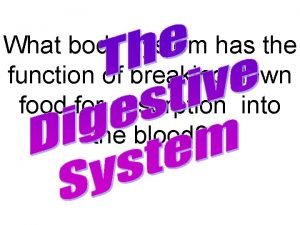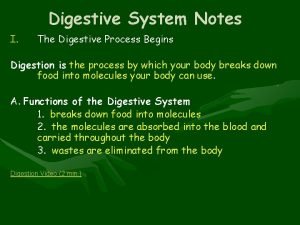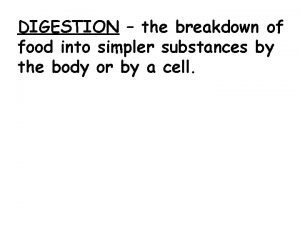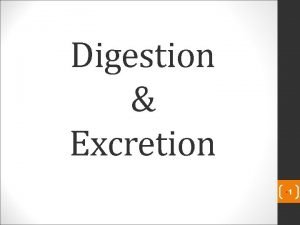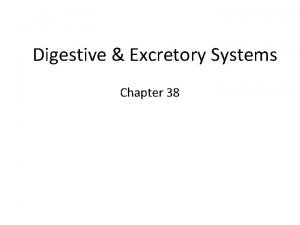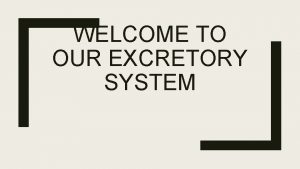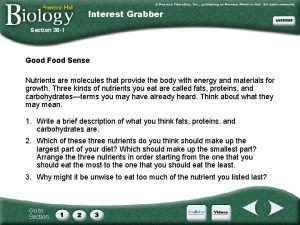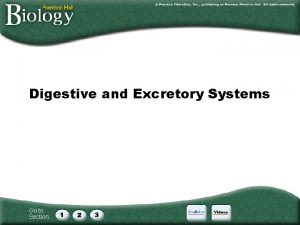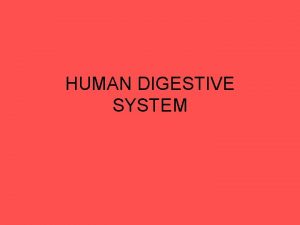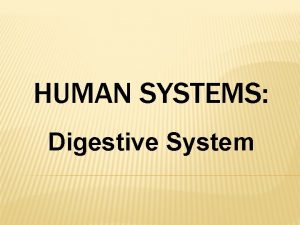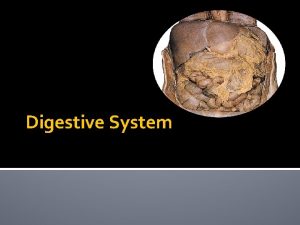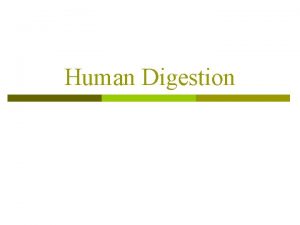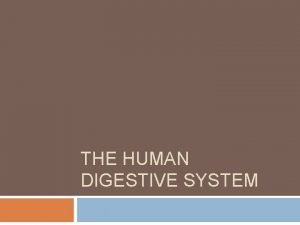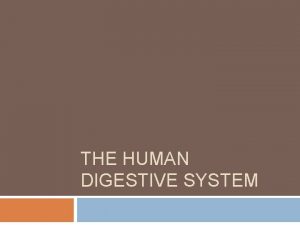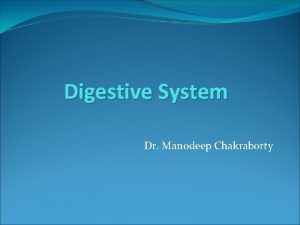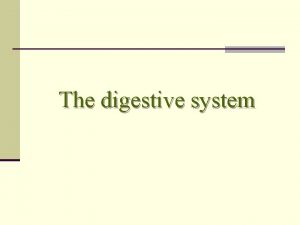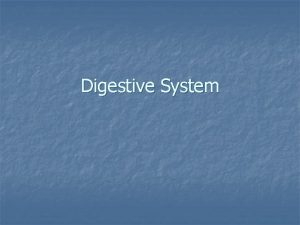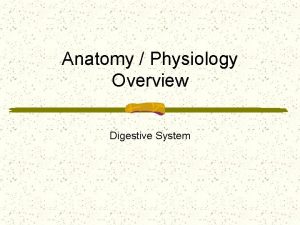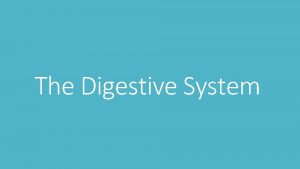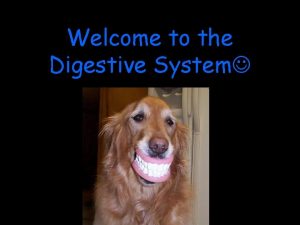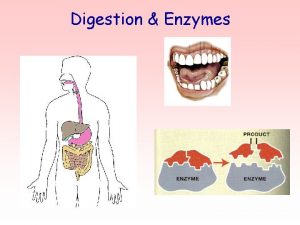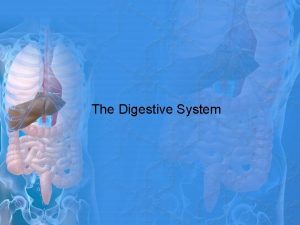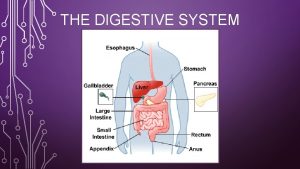The Digestive System Human Digestion Digestion n Process








































- Slides: 40

The Digestive System Human Digestion

Digestion n Process by which food molecules are broken down into simpler molecules that can be absorbed and used by the cells of the body – Nutrients are passed through cell membrane (absorption) but large particles must be broken down first.

Mechanical Breakdown n Chewing and cutting (teeth)

Chemical Breakdown n Digestive enzymes (saliva)

The Human Digestive System n n n Food passes n through the digestive n tube in the following n order n n n Oral cavity (mouth) Pharynx (throat) Esophagus (gullet) Stomach Small intestine Large intestine Rectum Anus

The Human Digestive System

The Mouth and Pharynx n Mechanical breakdown of food

The Mouth and Pharynx n Mechanical breakdown of food Teeth

The Mouth and Pharynx n Food mixed with saliva – 3 pair of salivary glands in mouth

The Mouth and Pharynx n Saliva wets food and causes it to stick together – Bolus – food mass

The Mouth and Pharynx n Chemical digestion in mouth with saliva – Salivary amylase – enzyme in saliva that breaks starch into maltose and glucose

The Mouth and Pharynx n Food pushes into pharynx n Epiglottis – flap of tissue covering trachea or pharynx so food/air goes down the right tube

Esophagus n Tube through which food passes from pharynx to stomach

Esophagus n Sphincter Muscle – ring of muscle where esophagus tube meets stomach

Esophagus n Peristalsis – rhythmic muscular movement of organs that “pushes” food through digestive tract

Stomach n Food broken down! – Mechanically: stomach contractions – Chemically: gastric juices secreted by glands in stomach walls

Stomach Glands Pyloric Gland – secretes mucus to cover stomach lining and protect it 2. Gastric Gland – secretes gastric juices 1. a. p. H of 1. 5 – 2. 5 (acidic) b. Contains HCl (hydrochloric acid) and pepsin (digestive enzyme that breaks down protein and curdles milk)

Stomach 3 mechanisms that stimulate the flow of gastric juices: 1. Thought, smell, sight, or taste of food sends message from brain to gastric gland 2. Food touching the stomach lining

Stomach 3. When food mass stretches stomach walls Stretching stimulates lining to secrete gastrin (hormone) into blood stream Gastrin signals gastric glands to produce large amounts of gastric juices

Stomach n Liquids pass through stomach in

Stomach n Liquids pass through stomach in 20 minutes or less

Stomach n Solids

Stomach Solids take longer n Reduced to thin soupy liquid – Chyme – that passes through Pyloric Sphincter (muscle controlling passage of chyme from stomach to small intestine) n

Stomach n ULCER – mucus layer of stomach breaks down and part of stomach wall is digested

Small Intestine n Fluids are alkaline n Chyme is mixed with bile from liver, pancreatic juice from pancreas, and intestine juice from small intestine

Small Intestine n Peristalsis * squeezes chyme through intestine * mixes chyme with digestive enzymes * breaks down chyme mechanically * speeds absorption by bringing contents into contact with intestinal walls

Small Intestine n Pancreatic Enzymes a. Amylase – breaks starch into maltose

Small Intestine n Pancreatic Enzymes a. Amylase – breaks starch into maltose b. Protease – breaks proteins trypsin chymotrypsin

Small Intestine n Pancreatic Enzymes a. Amylase – breaks starch into maltose b. Protease – breaks proteins trypsin chymotrypsin c. Lipase – breaks lipids

Small Intestine n Bile – from cells of liver and is stored in gallbladder n Aids in digestion of fats and oils by breaking them into tiny droplets – emulsification – and increases surface area for enzyme action

Small Intestine n Intestinal Juices – walls of small intestine contains millions of intestinal glands that secrete intestinal juices

Small Intestine n Absorption – small intestine is site of absorption of substances into blood vessels of circulatory system

Small Intestine n Small intestine contains folds and lining is covered with projections called villi

Large Intestine n Undigested and unabsorbed materials pass from small intestine to large intestine n NO digestion occurs here

Large Intestine n Lower right side of body where small intestine and large intestine meet is a pouch - appendix

Large Intestine n Main function of large intestine is reabsorption of water from food mass

Large Intestine n Main function of large intestine is reabsorption of water from food mass n Second function is to absorb vitamins produced by bacteria normally living in large intestine – Bacteria live on undigested food material and in turn produce vitamin K which is essential for blood clotting

Large Intestine n Third function is to eliminate undigested or indigestible material (feces)

Rectum n Stores feces

Anus n Feces eliminated from body here THE END!
 Respiratory system circulatory system digestive system
Respiratory system circulatory system digestive system Human digestive system facts
Human digestive system facts Biggest muscle in human body
Biggest muscle in human body Introduction
Introduction Introduction to
Introduction to Human digestive system in order
Human digestive system in order Write the correct sequence of human digestive system
Write the correct sequence of human digestive system Diagram of alimentary canal
Diagram of alimentary canal Digestive system diagram
Digestive system diagram Venn diagram of mechanical and chemical weathering
Venn diagram of mechanical and chemical weathering Nervous system and digestive system
Nervous system and digestive system The digestive process begins in the
The digestive process begins in the Breakdown of food
Breakdown of food Steps in the digestive system
Steps in the digestive system Section 38-1 food and nutrition
Section 38-1 food and nutrition The digestion process
The digestion process Carbohydrate digestion begins in the
Carbohydrate digestion begins in the Section 38-1 food and nutrition
Section 38-1 food and nutrition Section 38-3 the excretory system
Section 38-3 the excretory system Hát kết hợp bộ gõ cơ thể
Hát kết hợp bộ gõ cơ thể Lp html
Lp html Bổ thể
Bổ thể Tỉ lệ cơ thể trẻ em
Tỉ lệ cơ thể trẻ em Chó sói
Chó sói Glasgow thang điểm
Glasgow thang điểm Chúa sống lại
Chúa sống lại Các môn thể thao bắt đầu bằng tiếng đua
Các môn thể thao bắt đầu bằng tiếng đua Thế nào là hệ số cao nhất
Thế nào là hệ số cao nhất Các châu lục và đại dương trên thế giới
Các châu lục và đại dương trên thế giới Công của trọng lực
Công của trọng lực Trời xanh đây là của chúng ta thể thơ
Trời xanh đây là của chúng ta thể thơ Mật thư tọa độ 5x5
Mật thư tọa độ 5x5 Phép trừ bù
Phép trừ bù độ dài liên kết
độ dài liên kết Các châu lục và đại dương trên thế giới
Các châu lục và đại dương trên thế giới Thể thơ truyền thống
Thể thơ truyền thống Quá trình desamine hóa có thể tạo ra
Quá trình desamine hóa có thể tạo ra Một số thể thơ truyền thống
Một số thể thơ truyền thống Cái miệng nó xinh thế chỉ nói điều hay thôi
Cái miệng nó xinh thế chỉ nói điều hay thôi Vẽ hình chiếu vuông góc của vật thể sau
Vẽ hình chiếu vuông góc của vật thể sau Thế nào là sự mỏi cơ
Thế nào là sự mỏi cơ

